Contact Center
.
Crafts
 |
Al NaqdaNaqda is Arabic for the measuring unit of silver weight. Featured mostly in thoubs worn by women, bukhnaqs, and scarves, naqda embroidery has a hammered appearance achieved by the khoos strands used to create the designs. Khoos, which are thin strands of metal that come in either gold or silver, require a special needle to be pulled through cloth. Preferring tulle, wale cotton, and silk chiffons, the craftswomen thread the strands through cloth to create geometrical shapes, crescents, stars, and flowery motifs. |
 |
Basket WeavingBasket weavers utilize palm leaves to make several items available in Bahraini homes including the sofra dining mat, storage baskets, small dishes, hand fans and chicken coops. It is one of the most prominent crafts and is still practiced in several villages throughout the island. Basket weavers today can mainly be found in the villages of Karbabad, Jasra, and Budaiya. |
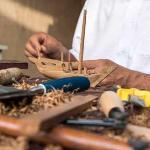 |
Boat MakingAs an island, boat making is a historic and iconic Bahraini industry. Over the centuries, Bahraini craftsmen developed a wide range of boats, each differing according to its purpose, from fishing, diving, pearling and transportation of goods and people. Made from lumber imported from India, the vessel exquisite balance in the high seas is testimony to the skill of Bahraini craftsmen.
|
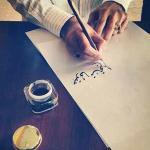 |
CalligraphyAs Arabic is the language of Islam and the Holy Quran, Arabic calligraphy spread in tandem with the growth and spread of the Islamic Empire. In a short span of time, Muslim artisans gave it a decorative beauty that no other calligraphy in the world has achieved. Due to the Islamic influence, many non-Arabic speaking nations became "arabized" and Arabic lettering spread among them, including India, Persia, parts of China, among others. |
 |
KurarKurar embroidery produces beautiful ribbons of gold zeri, silver zeri and briesam which are made by hand and used to decorate clothing. It is the result of a group effort in which the width of the final product depends on the number of women involved in the process. The Qataba sits opposite her partners, who assume the role of the Doakhil, holding and weaving several strands at a time while the Qataba guides the process and attaches the ribbon as it forms directly onto garments. While the popular korar zeri makes an appearance in many different styles of thoub, the breisam version is reserved exclusively for men’s clothing. |
 |
Palm Tree PaperBahrain’s identity has always been closely tied to palm trees. As a source of food and shelter, the palm tree has always been an indispensable element in the lives of Bahrainis. In an initiative to reinterpret the use of palm leaves, Children & Mothers Welfare Society encourages the Palm Paper Workshop involved in making handmade papers, cards, notebooks and illustrations. |
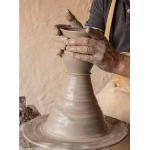 |
PotteryPottery is an industry Bahrain has been famous for since ancient times, as indicated by the vast quantity of millenniaold examples found in archaeological sites across Bahrain thanks to the availability of locally-sourced raw materials. The wide range of pottery on display illustrates the advanced level attained by Bahraini craftsmen who learned their trade from their forefathers. |
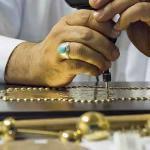 |
Traditional ChestsStill used as a decorative element in many houses, Sanadeeg Mubayata traditional chests also serve as storage for clothing and personal items. It’s appearance is distinguished by nail heads hammered into various decorative fashions. These chests are made out of real wood and are often used to present the bride with her trousseau. Storing zeri in a dark area when not in use helps maintain its shine and appearance. Today, several traditional chest designs have been reinterpreted and now incorporate a variety of colors. |
 |
Traditional InstrumentsMusic went handin- hand with the longstanding pearling heritage of Bahrain, as divers used song, dance, and music to pass time aboard the dhows in their long voyages at sea. As such, the country boasts a wide range of traditional instruments which can be viewed and purchased in this shop. |
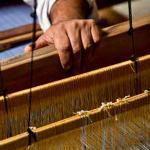 |
WeavingWorking on looms in Bani Jamra and Jasra, Bahrain’s fabric weavers inherit the trade from father to son, producing lengths of cloth to turn to irdeh, a black abbaya with lines of red and gold worn by women from rural areas, or the well known wezar, worn around the waist by men. Today, the craftsmen produce a multitude of items. In addition to traditional wear, scarves in varying colors are available for customization. While weaving, the craftsmen uses both his hands and legs and distributing and overlapping the threads into each other in a systematic and coordinated manner. |







